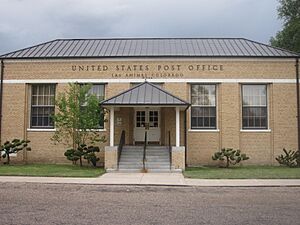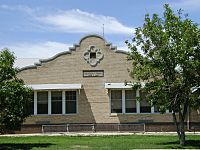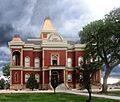Las Animas, Colorado facts for kids
Quick facts for kids
Las Animas, Colorado
|
||
|---|---|---|

City Hall (2010)
|
||
|
||
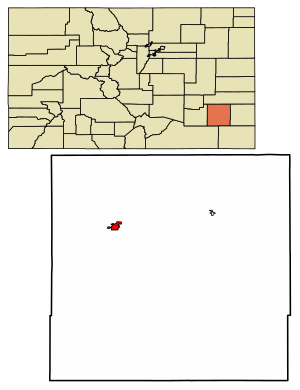
Location within Bent County and Colorado
|
||
| Country | United States | |
| State | Colorado | |
| County | Bent | |
| Incorporated | May 15, 1886 | |
| Area | ||
| • Total | 1.67 sq mi (4.33 km2) | |
| • Land | 1.63 sq mi (4.21 km2) | |
| • Water | 0.05 sq mi (0.12 km2) | |
| Elevation | 3,898 ft (1,188 m) | |
| Population
(2020)
|
||
| • Total | 2,300 | |
| • Density | 1,380/sq mi (531/km2) | |
| Time zone | UTC−7 (MST) | |
| • Summer (DST) | UTC−6 (MDT) | |
| ZIP Code |
81054
|
|
| Area code | 719 | |
| FIPS code | 08-43660 | |
| GNIS ID | 195526 | |
Las Animas is a city in Bent County, Colorado, United States. It is the main town and the county seat. In 2020, about 2,300 people lived there.
The city is located on the Arkansas River. It is just west of where the Purgatoire River (also called "Purgatory River") joins the Arkansas River. Las Animas is in southeast Colorado, east of Pueblo. It is also near the historic Bent's Fort.
Contents
- What's in a Name? The Story of Las Animas
- A Look Back: Las Animas History
- Where is Las Animas? Geography
- =Weather in Las Animas: Climate
- Who Lives in Las Animas? Demographics
- Celebrating History: Santa Fe Trail Day
- Learning in Las Animas: Education
- Getting Around: Transportation
- Famous People from Las Animas
- Images for kids
- See also
What's in a Name? The Story of Las Animas
The name "Las Animas" means "The Souls" in Spanish. There's a legend about how the town and the Purgatoire River got their names. It says that a group of Spanish explorers, possibly with Coronado, died without a priest to give them their last rites. In Catholic belief, this meant their souls might go to Purgatory.
The full Spanish name for the city was supposedly "The city of lost souls in Purgatory." However, some historians say this story doesn't quite fit with Spanish Catholic beliefs. It might be more of a French Catholic idea.
Old maps from the 1800s don't show this long Spanish name. They use different names for the river, like "Río de Las Ánimas" or "Purgatory River." French fur traders in the 19th century called the river the Purgatoire. Today, people often call it "Picketwire."
A Look Back: Las Animas History
Early Settlements and Forts
An early trading post called Gantt's Picket Post (also known as Fort Gantt) was built near where Las Animas is today. It operated from 1832 to 1834. Later, the second Fort Lyon military base was built in Las Animas in 1867. This fort was active until 1897.
Challenges with Water
Water is a very important topic in Las Animas. Like many towns in southeastern Colorado, Las Animas needs water for its people and for farming. However, it often has to compete with larger, richer cities for this water.
During times of drought or when crop prices are low, developers and cities sometimes buy water rights from farmers. This water is then sent upstream to bigger cities. This means Las Animas loses access to this vital resource.
In the mid-1990s, a special water filter was put in place to improve the city's water quality. But this process removed minerals from the water. These minerals had actually helped support the old water pipes. Without them, many pipes collapsed.
Where is Las Animas? Geography
Las Animas is located in the northwest part of Bent County. It sits along the Arkansas River. U.S. Highway 50 is the main road through the city. It goes west about 82 miles (132 km) to Pueblo and east about 36 miles (58 km) to Lamar.
The city covers a total area of about 1.67 square miles (4.3 square kilometers). Most of this area, about 1.63 square miles (4.2 square kilometers), is land. A small part, about 0.05 square miles (0.12 square kilometers), is water.
=Weather in Las Animas: Climate
Las Animas is often one of the warmest cities in Colorado. However, winters can still be quite cold. The lowest temperature ever recorded in Las Animas was −32°F (−36°C) on January 28, 1948. The highest temperature ever recorded was 114°F (46°C) on June 24, 2012.
Each year, there are usually about 83 days when the temperature reaches 90°F (32°C) or hotter. About 22 of those days reach at least 100°F (38°C).
| Climate data for Las Animas 1991-2020 normals, extremes 1893- | |||||||||||||
|---|---|---|---|---|---|---|---|---|---|---|---|---|---|
| Month | Jan | Feb | Mar | Apr | May | Jun | Jul | Aug | Sep | Oct | Nov | Dec | Year |
| Record high °F (°C) | 84 (29) |
85 (29) |
94 (34) |
100 (38) |
106 (41) |
114 (46) |
114 (46) |
110 (43) |
106 (41) |
99 (37) |
90 (32) |
88 (31) |
114 (46) |
| Mean daily maximum °F (°C) | 47.8 (8.8) |
51.6 (10.9) |
61.8 (16.6) |
69.6 (20.9) |
79.2 (26.2) |
90.0 (32.2) |
94.5 (34.7) |
91.7 (33.2) |
84.6 (29.2) |
71.3 (21.8) |
58.2 (14.6) |
47.6 (8.7) |
70.7 (21.5) |
| Mean daily minimum °F (°C) | 15.5 (−9.2) |
19.3 (−7.1) |
28.1 (−2.2) |
36.8 (2.7) |
47.5 (8.6) |
57.8 (14.3) |
63.0 (17.2) |
61.1 (16.2) |
51.9 (11.1) |
37.4 (3.0) |
24.9 (−3.9) |
16.0 (−8.9) |
38.3 (3.5) |
| Record low °F (°C) | −32 (−36) |
−31 (−35) |
−26 (−32) |
5 (−15) |
17 (−8) |
32 (0) |
32 (0) |
34 (1) |
22 (−6) |
−1 (−18) |
−14 (−26) |
−32 (−36) |
−32 (−36) |
| Average precipitation inches (mm) | 0.38 (9.7) |
0.32 (8.1) |
0.78 (20) |
1.36 (35) |
1.69 (43) |
1.81 (46) |
2.63 (67) |
1.82 (46) |
0.93 (24) |
1.10 (28) |
0.40 (10) |
0.36 (9.1) |
13.58 (345.9) |
| Average snowfall inches (cm) | 3.9 (9.9) |
2.3 (5.8) |
3.3 (8.4) |
0.4 (1.0) |
0 (0) |
0 (0) |
0 (0) |
0 (0) |
0 (0) |
1.5 (3.8) |
1.9 (4.8) |
2.9 (7.4) |
16.2 (41.1) |
| Average precipitation days (≥ 0.01 in) | 2.7 | 3.1 | 4.5 | 5.4 | 6.9 | 6.5 | 7.3 | 6.8 | 4.3 | 4.3 | 2.8 | 2.7 | 57.3 |
| Average snowy days (≥ 0.1 in) | 1.8 | 1.8 | 1.2 | 0.3 | 0 | 0 | 0 | 0 | 0 | 0.4 | 1.1 | 1.9 | 8.5 |
| Source 1: NOAA | |||||||||||||
| Source 2: NCEI | |||||||||||||
Who Lives in Las Animas? Demographics
| Historical population | |||
|---|---|---|---|
| Census | Pop. | %± | |
| 1880 | 52 | — | |
| 1890 | 611 | 1,075.0% | |
| 1900 | 1,192 | 95.1% | |
| 1910 | 2,008 | 68.5% | |
| 1920 | 2,252 | 12.2% | |
| 1930 | 2,517 | 11.8% | |
| 1940 | 3,232 | 28.4% | |
| 1950 | 3,223 | −0.3% | |
| 1960 | 3,402 | 5.6% | |
| 1970 | 3,148 | −7.5% | |
| 1980 | 2,818 | −10.5% | |
| 1990 | 2,481 | −12.0% | |
| 2000 | 2,758 | 11.2% | |
| 2010 | 2,410 | −12.6% | |
| 2020 | 2,300 | −4.6% | |
| U.S. Decennial Census | |||
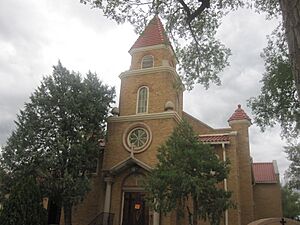
In 2000, about 2,758 people lived in Las Animas. There were 1,091 households. About 31% of these households had children under 18 living with them. The average household had 2.46 people.
The population was spread out by age. About 27.3% were under 18 years old. About 17.9% were 65 years or older. The average age was 38 years.
The median income for a household in the city was $26,157. This means half of the households earned more than this, and half earned less. About 25% of the people in Las Animas lived below the poverty line. This included 39.3% of those under 18.
Celebrating History: Santa Fe Trail Day
Las Animas is located along the Mountain Branch of the Santa Fe Trail. This trail was an important route for pioneers and traders. Las Animas was the biggest city in southeast Colorado for a while. This changed when the Atchison, Topeka and Santa Fe Railroad started operating in La Junta, about 20 miles (32 km) west.
Las Animas celebrates an annual Santa Fe Trail Day. This event honors the pioneers and traders who used the trail. It's the oldest student council-sponsored event in the United States! The Las Animas High School Student Council organizes the day. They get help from the Bent County Chamber of Commerce.
Past celebrations have included a parade, a costume contest, square dancing, and a demolition derby. There's also a traditional "Ranchburger" lunch and many other fun activities. Since 2002, students have spread the events over two days, sometimes making it a weekend celebration.
Here are some important dates for Santa Fe Trail Day:
- April 26, 2002: This was the first time the event officially became a multi-day celebration.
- April 24, 2009: Las Animas celebrated its 75th Annual Santa Fe Trail Day. Special guests included former Santa Fe Trail Day Queens and Student Council Presidents, some from as far back as 1944.
- April 24, 2020: Due to the COVID-19 pandemic, the community parade was not allowed for the first time in its history.
- April 26–28, 2024: Events were planned to celebrate the 90th anniversary.
Learning in Las Animas: Education
Columbian Elementary School
Columbian Elementary School was built in 1916. It replaced an older school from 1887. This school was special because it was the only building in Las Animas built in the Spanish architecture style. It was also the only school in Colorado with an open courtyard.
In 2004, the school was added to the National Register of Historic Places. It was important, but it needed a lot of repairs to keep being used. It was even on a list of endangered places in Colorado.
While people tried to save the old building, a new school was built next to it. The old school was eventually torn down on February 21, 2006. This was because the School Board felt it was too expensive to fix. The new elementary school is now located just west of where the old one stood.
Getting Around: Transportation
Las Animas is part of the Bustang bus network. It is on the "Lamar-Pueblo-Colorado Springs Outrider" line. This helps people travel to and from the city.
Famous People from Las Animas
Many interesting people have lived in or were born in Las Animas. These include:
- William Bent: A fur trader and rancher.
- Ken Curtis: An actor and singer.
- Mari Yoriko Sabusawa: An editor and supporter of the arts.
Images for kids
See also
 In Spanish: Las Ánimas (Colorado) para niños
In Spanish: Las Ánimas (Colorado) para niños



